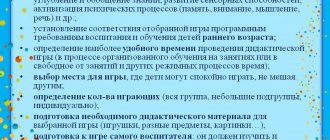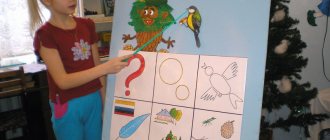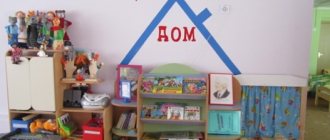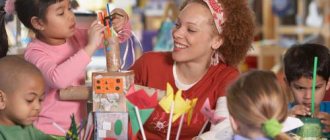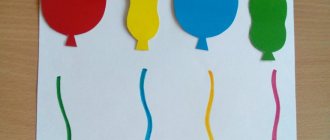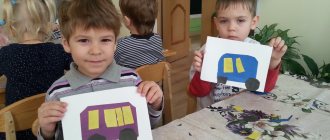Mathematics plays a major role in the development of a preschooler’s intelligence. And one of the main tasks of the teacher is to arouse the child’s interest in this subject. Then the assimilation of knowledge will be successful, which will undoubtedly be useful to the child in school life. A game will help to engage your child in mathematics. It develops the child’s cognitive activity in a relaxed manner, gives him the opportunity to develop as a person, and teaches him to manage himself.
- 2 The main types of game-based mathematical activities in the middle group of preschool educational institutions
2.1 Didactic games in mathematics in the middle group: card index (with application purposes) - 2.2 Outdoor games
- 2.3 Logic games
- 3.1 Notes of game mathematical classes
3.3.1 Photo gallery: homemade educational games in mathematics
The main types of game-based mathematical classes in the middle group of preschool educational institutions
The variety of gaming material according to FEMP is the basis for its classification. Games differ in content, the nature of mental operations, and their focus on developing certain skills and abilities.
Depending on the type of intended activity, didactic, active and logical games based on FEMP can be distinguished.
Didactic games in mathematics in the middle group: card index (with application purposes)
A wide variety of didactic games are a universal means of developing mathematical concepts in children of the fifth year of life. At the same time, subject and verbal games are usually carried out directly during the educational lesson, while board-print games are appropriate to offer to preschoolers in their free time.
Such manuals are appropriate for teaching preschoolers in their free time.
Among the didactic games in mathematics for the middle group, the following groups can be distinguished:
- games that develop the ability to compare quantity and number (for example, “Tea Set”, “Help the turtle find his island”, etc.);
- game aids for mastering knowledge of geometric figures (“Domino of figures”, “Teremok”, “Wonderful bag”, “Mongolian game”, “Columbus egg”, “Make up triangles”, etc.);
- manuals introducing the concept of time (for example, “First and Then”);
- games that reinforce ideas about directions (right, left), the location of objects in space (“Birch”, “Labyrinths”, “Aquarium”, etc.);
- manuals that develop attention, the ability to carefully examine objects”, find similarities and differences (“Find the Differences”, “Merry Little Mice”, “Shadows of Fairy-Tale Characters”, etc.).
Let's take a closer look at some of these games.
"Help the turtle find his island." Each turtle that swims in the sea has its own house - an uninhabited island where it can relax and lie in the sun. The island number corresponds to the number of spots on the shell. The kids' task is to place each turtle in its own house. Such a game aid is appropriate to use for individual work with middle school students in their free time, and can also be included in group work in the classroom: cards are hung on the board, and several preschoolers take turns coming up and performing actions.
Didactic game on the ratio of quantity and number
"Tea-set". The principle of the game is similar to the previous version. The teacher reports that the dolls want to drink tea. To do this, they need tea pairs: in this case, the number on the cup must correspond to the number of items on the saucer.
The goal of the game is to learn how to correlate quantity and number
"Teremok". The teacher invites the children to act out a fairy tale they know. But what is unusual is that its heroes will not be little animals, but geometric figures who want to live in a beautiful house. By the way, with the help of such a fairy tale, children usually remember well the figures that are complex for their age - the trapezoid and the oval.
Dramatization game with characters - geometric shapes
"Domino figures". The play set also reinforces children's knowledge of geometric shapes. You can play it collectively (several people) in your free time.
The game reinforces the ability to distinguish geometric shapes
"First and then." For children of the fifth year of life, understanding temporal concepts is quite difficult. An exciting didactic game will come to the rescue. The children are offered pictures in which objects are depicted in their original state (a ball, a caterpillar, a spikelet, seeds, a baby, etc.).
Images of original items and objects
The left side of the card is free - you need to put what you ended up with there. For example, a little chicken grew into a big beautiful rooster, a caterpillar turned into a beautiful butterfly, a house was built from a pile of bricks, and a sunflower grew from a seed.
The pictures depict what objects and objects have become after some time.
"Aquarium". Preschoolers must name the spatial direction of the fish (swims left/right, top/bottom of the aquarium).
The first option for the location of the fish
Then another picture is shown, which shows the same fish, but they are located differently. Kids also analyze their location in space.
The second option for the location of objects
"Mongolian game". Children are offered sets of geometric shapes, from which they need to create a picture according to the proposed model (it is hung on the board).
Preschoolers make various images from geometric shapes
Outdoor games
Mathematical knowledge in the middle group is also successfully acquired if the process of cognition is inextricably linked with the motor activity of the preschooler. For example, using Dienesh blocks, a teacher can organize the game “Find your house.” Each pupil receives a figure (of a certain shape, color, size and thickness). The music turns on and the children start dancing. At the end of the musical composition, everyone must be distributed among the “houses” - run up to the table on which lies a triangle, square, circle or rectangle. Then the principle of the game changes - you need to sort by the color of the figure (yellow, red and blue) or by size (large or small figure).
Using Dienesh blocks, you can organize an exciting outdoor game with middle school students
Another active math game is “Let’s move.” The teacher hits the tambourine a certain number of times. Children carefully count the blows, and then make the same number of movements (they are agreed upon in advance - kids clap their hands, jump on the spot, etc.)
The game “Guess It” helps middle school students remember various geometric shapes. The kids form a circle, in the center of which stands a teacher with a ball. He shows a shape (for example, a red circle), and the children must say what it looks like (an apple, a tomato, etc.). The child to whom the teacher rolls the ball answers.
"Butterflies and Flowers." Cardboard flowers are laid out on the floor (according to the number of preschoolers). The teacher tells the children that they are turning into butterflies (the children flap their imaginary wings). Butterflies fly around the room to the accompaniment of music. As soon as she stops, each child must stand near the flower. At the same time, the teacher clarifies that the number of flowers coincides with the number of butterflies - they are equal. Thus, this game strengthens the ability of middle group students to compare groups of objects with each other.
Finger games or eye exercises can also have mathematical content. Kids usually love such activities very much.
"Bees"
| A small house on a Christmas tree, | One hand depicts a Christmas tree: resting on the elbow, fingers spread. The second hand is a beehive: the fingers are closed in a ring. The hive is pressed against the tree. |
| A house for bees, where are the bees? | We look into the hive. |
| You have to knock on the house, One, two, three, four, five. | Knock your fists against each other. |
| I knock and knock on the tree, Where, where are these bees? | We knock our fists against each other, alternating hands. |
| The bees began to fly out: One, two, three, four, five! | We spread our hands, spread our fingers and move them, the bees fly. |
“The fingers went out for a walk”
| One two three four five | Fingers in a fist, alternately showing fingers. |
| The fingers went out for a walk. | We clench and unclench our fist. |
| One two three four five. | We clench our fingers into a fist one by one. |
| They hid in the house again. | Hide your fists behind your back. |
"Toys"
| On a large sofa, Katina's dolls are sitting in a row: | Alternately clap hands |
| Two bears, Pinocchio and cheerful Cipollino, and a kitten and a baby elephant. | Bend all fingers one by one. |
| One two three four five. | Extend your fingers one by one. |
| We help our Katya We collect toys. | Alternately clapping hands and banging fists |
"Kitty"
| I walked alone along the path, | Show one finger |
| My two legs walked with me, | Show two fingers |
| Suddenly three mice meet, | Show three fingers |
| Oh, we saw a kitten! | Shaking our heads |
| He has four legs | Show four fingers |
| There are sharp scratches on the paws, | Scratch your nails on the table or on your knees |
| One two three four five, | For each count we show the corresponding number of fingers. |
| We need to run away quickly! | We run away with the index and middle fingers |
Gymnastics for the eyes “Cat”
- Now the window has opened,
- The cat came out onto the ledge.
- The cat looked up
- The cat looked down.
- Here I turned to the left,
- She watched the flies.
- She stretched, smiled and sat down on the ledge.
Logic games
Mastering mathematics is, first of all, associated with the development of logical thinking. And games will again come to the aid of the kids. Let's give a number of examples.
“What will happen?” The game manual consists of logical pictures that prepare middle school students for the operations of addition and subtraction that they will have to master at an older age.
The game prepares kids for addition and subtraction
A logic game can be verbal (without using visual aids). For example, children must complete the phrase:
- If two are more than one, then one... (less than two).
- If Sasha left the house before Seryozha, then Seryozha... (left later than Sasha).
- If the river is deeper than a stream, then the stream... (smaller than a river).
- If the right hand is on the right, then the left ... (on the left).
- If the table is higher than the chair, then the chair... (below the table).
"Guess what I see." The teacher selects a certain round (or square, triangular) shaped object in the group room and invites the children to guess it. At the same time, the kids are given hints: for example, it (the object) is rectangular, large, green (board).
How to conduct a game lesson on FEMP in a middle group
Mathematical classes are always exciting and are completely game-based.
Abstracts of game mathematical classes
| Author's full name | Title of the abstract |
| Morozova L.S. | “My home village “Belye Berega”” (lesson for middle group) Educational objectives: teach counting to 5; introduce preschoolers visually to the formation of the number 5; consolidate knowledge of numbers from 1 to 5; learn to compare the numbers 4 and 5 based on comparison of sets, obtain equality from inequality; consolidate knowledge of geometric shapes; expand children's knowledge about their small homeland. Developmental tasks: improve memory, attention, logical thinking, develop imagination and speech activity. Educational tasks: to form patriotic feelings in preschoolers towards their small Motherland. Integration of educational areas: “Cognition”, “Communication”, “Socialization”, “Physical education”, “Health”, “Formation of a holistic picture of the world”. Demo material: yellow and blue house models (5 pieces each); Handout: sheets of paper with two cells arranged in two rows; paper numbers from 1 to 4 (according to the number of children), geometric shapes - blue squares and triangles, yellow and red circles (according to the number of children). Progress of the lesson 1. Conversation. Educator. Children, tell me what the Motherland is? (This is the place where a person was born and lives). - Who can tell me what the name of the locality in which you and I live is? (White Berega) - How many of you know what street our kindergarten is located on? (Proletarskaya Street) Guys, today I want to go on a trip with you. Tell me, what can you travel with? (By plane, train, hot air balloon, car, bicycle, scooter, motorcycle, bus, etc.) - That's right, well, I suggest you fly in a hot air balloon. Let's remember what this vehicle looks like? (It is large, beautiful, round in shape, with a special basket for passengers at the bottom). — What is the balloon filled with? (By air). - Let us now fill the dome of our balloon with air. (Preschoolers perform a breathing exercise - intensively blow with their mouths). And you know that getting into the basket is not easy. Those of you who give your home address will come in first (and the rest will come in after them, all together). - Well, great, we are ready to travel. And we will move around our village of Belye Berega. 2. Word game “It’s so.” Preschoolers stand near the teacher. Educator. Guys, while we are flying, I will tell you what is available in our native village. If the statement is true, you will say, “It is so.” And if it’s wrong, you’ll say, “That’s not true.” There is a hospital in our village. (This is true). There is a circus. (This is wrong). There is a train station. (This is true). There is a museum of the Great Patriotic War. (This is wrong). There is an Art School. (This is true). There is a Paper Factory (That's right). There is a swimming pool. (This is wrong). 3. Game exercise “Houses on Stroiteley Street.” The teacher hangs house models of two colors (4 yellow and 5 blue) on the board. Educator. Guys, our balloon landed on Stroiteley Street. Yellow and blue houses were built on Stroiteley Street. Count how many houses are yellow and how many are blue. (Several children take turns approaching the board and counting.) —Which houses are there more? (Blue). Less? (Yellow). How much more? (For one house). How much less? (Also for one). - What needs to be done to make the number of houses the same? (Build another yellow house). The child attaches another yellow house to the board. - Now let's count how many houses there are on Stroiteley Street. (Several children take turns approaching the board and counting.) 4. Game exercise “Housing the tenants.” Educator. Guys, a new two-story house was recently built on Stroiteley Street. And you can help resettle residents into apartments. Handouts have been prepared in advance on the tables (paper models of houses - sheets with two squares in two rows, numbers from 1 to 4). Children complete the task independently. Educator. On the ground floor, in the apartment located on the right, 4 residents will live. (Preschoolers place the number 4 in the right cell in the bottom row; similarly, as instructed by the teacher, the remaining cells are filled in.) 5. Physical education minute. “And now you and I will rest a little.”
6. Game exercise “Plant a flowerbed.” Educator. Guys, tell me, are there flowering flower beds in our village? True, they are very beautiful and delight our eyes. Let's make sure there are even more of them. Geometric shapes are laid out on the carpet. The teacher invites preschoolers to take one geometric figure each. Educator. Place a large yellow circle in the very middle of the flowerbed. Place blue squares around the yellow circle. And place red circles between them. Place a blue triangle on the large yellow circle. Place small yellow circles on top of the red circles. - Great, so we made a flowerbed with you. 7. Low mobility game with the ball “Our Village”. Preschoolers stand in a circle, and the teacher is in the center. Educator. Now let’s play the game “Our Village”. I will take turns throwing the ball to you, and you must give beautiful words to our village. Let's praise him. What is he like? (Wonderful, big, beloved, sunny, friendly, green, cozy, dear, modern, etc.) Educator. Our fascinating journey through the village of Belye Berega has come to an end. Our balloon landed on the territory of our kindergarten. It's time to go out. |
| Morozova L.S. | “Turnip” (game-based mathematical lesson on a Russian folk tale for the middle group) The teacher invites the children to remember a familiar fairy tale. During the story, kids answer questions and lay out characters on the board (several people are called in turn). Examples of questions: 1. Who began to pull the turnip first? 2. What number was the grandmother? 3. Who is standing in front of the Bug? 4. Who was the last to pull the turnip? The next task is related to the consolidation of the concepts of “tall and short”: Who is the tallest character in the fairy tale “Turnip”? Who is the shortest? The teacher mixes the characters, and the children must arrange them by height (preschoolers are offered handouts). And finally, the kids must treat four of their friends to turnips. To do this, the paper silhouette of a turnip (which lies on each child’s table) must first be cut into two parts, and then in half again until four parts are formed. |
Long-term plan for introducing didactic games with mathematical content for the middle group for a year
Educator: Morozova L.S. (Some games are slightly ahead of the middle group program, since preschoolers additionally attended a math club)
| Month | Game name, goal |
| September | “Help the turtle find his island” Goal: to develop the ability to correlate quantity and number. “Cheerful little mice” Purpose: to repeat counting, colors, to develop memory, visual perception, observation, to practice the formation of the genitive case singular form. |
| October | “Shapes” Goal: consolidation of knowledge about key geometric figures, development of memory, speech, attention, fine motor skills, learning to find objects of similar shape in everyday life and the environment and classify them. “Find the differences” Goal: to improve the ability to consistently examine objects, compare them, establish similarities and differences, develop counting skills, develop sustained attention, and activate children’s speech. |
| November | “First and then” Purpose: to form initial ideas about the fluidity of time. “Tea set” Purpose: to improve the ability to correlate quantity and number. |
| December | “Mongolian game” Goal: development of sensory skills, spatial concepts, the ability to analyze the complex shape of objects, thinking, perseverance, and quick wits. “Numbers” Purpose: familiarization with numbers, exercise in mental calculation, training of attention, thinking, improving coordination of movements. |
| January | “Labyrinths” Purpose: to develop logic, attention, ability to concentrate, fine motor skills, imagination. “Learning to count” Goal: to develop the ability to correlate quantity and number, develop associative thinking, improve fine motor skills of the hands. |
| February | “Shadows of fairy-tale characters” Purpose: to learn to find given silhouettes, consolidate knowledge of fairy-tale characters, develop visual perception, visual superimposition techniques, attention, perseverance, logical thinking. “Easy counting” Purpose: to practice counting up to 5 (forward and backward), to familiarize with the composition of numbers within 5. |
| March | “Sleeping Beauty's Castle” Goal: repeat counting to 5, practice the relationship between quantity and number. “Columbus Egg” Goal: development of sensory skills, spatial concepts, the ability to analyze objects and images of complex shapes. |
| April | “Tale after Tale” Purpose: to practice counting, to teach how to unite people according to their occupations and emotional states. “Fun Counting” Purpose: familiarization with counting, development of memory, logical thinking and attention. |
| May | “Birch” Goal: to consolidate ideas about the relative position of objects in space (left and right, above and below, between and next to); repeat familiar geometric shapes, improve the ability to distinguish objects by width, develop orientation on a sheet of paper. “My first watch” Goal: to learn to tell time on a watch, to develop the ability to correlate your daily routine with the time on a watch, to train fine motor skills. |
How to make a didactic math game for the middle group with your own hands
Of course, today there is a huge number of a wide variety of didactic games on sale, including those with mathematical content. However, a teacher who is passionate about his work will be interested in making such a developmental manual on his own. This does not require special material costs, but only a little time and desire.
Let's give examples of such homemade games.
- With the help of the game “Funny Little Mice,” children repeat counting, train attention, and at the same time practice forming the genitive singular form. According to the plot of the game, the mice found paints and began to paint with their tails, got dirty and now they are afraid to catch their mother’s eye. The teacher asks preschoolers how many mice are in the picture, what colors they are, reports that one mouse ran away and shows the corresponding image. The children must say which mouse is gone. Next, the picture with 3 and 2 mice is played out in a similar way. To make such a game, you need to draw four pictures showing mice of different colors (their number is also different).
- In the game guide “Shadows of Fairy-tale Heroes,” magical characters are enchanted, and the spell can be removed only by returning each person’s shadow. The teacher offers pictures depicting popular fairy-tale characters and their shadows, and their number is different (there are fewer magical characters than shadows). Preschoolers return the shadows to their owners and by the remaining shadow (Baba Yaga) they find out who bewitched them. This game develops visual perception, visual superimposition techniques, children practice quantitative and ordinal counting, while consolidating knowledge of fairy-tale characters.
- The game "Birch" reinforces the concepts of the spatial arrangement of objects, as well as color and shape. To create such a manual, the teacher needs to draw a large birch tree (on a piece of Whatman paper), colorful birds and birdhouses for them (each house has a roof of a certain color and an entrance of a round, square or triangular shape). Children are given various tasks, for example, placing a blue bird in a birdhouse with an orange roof, located on the lower branch on the left.
Photo gallery: homemade educational math games
The game reinforces preschoolers’ knowledge of the spatial arrangement of objects, knowledge of color and shape
The game is aimed at training counting, developing attention and consolidating colors.
The game guide develops attention and visual superimposition techniques
Play is a great joy for a preschool child, while at the same time developing important mental processes (thinking and attention, memory and speech). While playing, a child gains new knowledge and skills, often without even realizing it. Conducting math classes in the middle group in a playful way develops children intellectually and increases their cognitive interest. In addition, such activities are useful for the socialization of preschoolers - it teaches them to communicate with each other and the teacher.
Junior group
Kindergarteners of the younger age group, that is, 2-3 years of age, in the process of games learn to distinguish the shapes and sizes of objects, compare, place in a certain order, use the acquired concepts in practice, act constructively and accurately. The card index of didactic games “Magnitude” includes activities that develop visual and tactile perception, motor skills of the fingers, cultivating curiosity and perseverance.
Balls
For the game, prepare a tight box that can be opened. Cut two round holes in its upper wall: one of large diameter, the other of small diameter. Take two balls of different sizes for the game, and the larger one should fit the large hole, but be larger than the small hole.
Invite students to hold both balls. Children must understand that a large ball is heavier and cannot be squeezed in their palms. A small one weighs less and is easy to hide in clenched hands. Both balls, thanks to their edgeless shape, roll easily.
Children try to put the balls into the holes in the box. The big one falls into the large hole, but remains lying on the shallow one. And a small ball can be easily dropped into both a large and a small hole.
Toys play hide and seek
To play, take toys representing animals and people. They must be of different sizes. Also prepare boxes of different sizes in quantities corresponding to the number of toys.
Tell the students that the toys decided to play hide and seek. We need to help them hide safely. Children try to fit toys into boxes and cover them tightly with lids. If the item does not fit, then it is too large, you need to find another hiding place for it. The game continues until the children distribute all the toys correctly into the boxes.
Magic bag
Take an opaque bag for play, place toys and things of different sizes in it. Then you can play in the following way:
- ask the child to feel and get only small objects;
- offer to take out only large things;
- pull out objects one by one, naming their size.
Turret
To play, take 5 different-sized game cubes. It is advisable that they be the same color: this will make it easier for the child to concentrate on the task.
Invite your student to build a tower for the princess out of cubes. Explain to your child how buildings are built so that they are sustainable. First you need to take the largest cube, it will be the foundation, put a smaller one on it, then an even smaller one. The smallest cube becomes the top of the turret. After hearing the explanation, the student completes the task independently.
